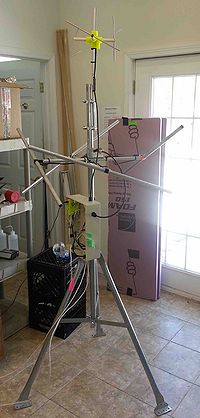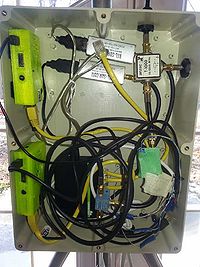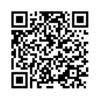Difference between revisions of "SatNOGS no-rotator Ground Station"
(→For the enclosure and SatNOGS parts) |
|||
| (2 intermediate revisions by one user not shown) | |||
| Line 30: | Line 30: | ||
==== Antennas ==== | ==== Antennas ==== | ||
The UHF Paralindy I built for this project: | The UHF Paralindy I built for this project: | ||
| − | * I followed these directions for measurements | + | * I followed these directions for measurements: [https://www.amsat.org/wordpress/wp-content/uploads/2014/01/70ParaLindy.pdf] |
| + | ** I printed a central hub rather than using PVC parts, if/when cshields makes the part public I can link to that part | ||
* 1/8" aluminum welding rod, find local source | * 1/8" aluminum welding rod, find local source | ||
* 1/2" PVC water pipe | * 1/2" PVC water pipe | ||
| Line 50: | Line 51: | ||
* cell phone with clinometer app | * cell phone with clinometer app | ||
* 6-8" of 1" diameter shrink tubing | * 6-8" of 1" diameter shrink tubing | ||
| + | * 3D printed "T's" for the elements: [https://www.thingiverse.com/thing:3351379 https://www.thingiverse.com/thing:3351379] | ||
==== Coax parts ==== | ==== Coax parts ==== | ||
| Line 60: | Line 62: | ||
* Enclosure - [https://www.amazon.com/gp/product/B075X51N77/ref=ppx_yo_dt_b_asin_title_o05__o00_s00?ie=UTF8&psc=1] | * Enclosure - [https://www.amazon.com/gp/product/B075X51N77/ref=ppx_yo_dt_b_asin_title_o05__o00_s00?ie=UTF8&psc=1] | ||
* Bag of Cable Glans - [https://www.amazon.com/gp/product/B0748JLNR4/ref=ppx_yo_dt_b_asin_title_o05__o00_s00?ie=UTF8&psc=1] | * Bag of Cable Glans - [https://www.amazon.com/gp/product/B0748JLNR4/ref=ppx_yo_dt_b_asin_title_o05__o00_s00?ie=UTF8&psc=1] | ||
| − | * 5 port Ethernet Hub, 5v - [https://www.amazon.com/gp/product/B000M2TAN4/ref=ppx_yo_dt_b_asin_title_o06__o00_s00?ie=UTF8&psc=1] | + | * 5 port Ethernet Hub, 5v - [https://www.amazon.com/gp/product/B000M2TAN4/ref=ppx_yo_dt_b_asin_title_o06__o00_s00?ie=UTF8&psc=1] (only if you are attaching multiple RPi clients) |
* 10x 16GB microSDR - [https://www.amazon.com/gp/product/B00WUCNGVQ/ref=ppx_yo_dt_b_asin_title_o09__o00_s00?ie=UTF8&psc=1] | * 10x 16GB microSDR - [https://www.amazon.com/gp/product/B00WUCNGVQ/ref=ppx_yo_dt_b_asin_title_o09__o00_s00?ie=UTF8&psc=1] | ||
* RPi3 x3 - [https://www.amazon.com/gp/product/B01LPLPBS8/ref=ppx_yo_dt_b_asin_title_o09__o00_s00?ie=UTF8&psc=1] | * RPi3 x3 - [https://www.amazon.com/gp/product/B01LPLPBS8/ref=ppx_yo_dt_b_asin_title_o09__o00_s00?ie=UTF8&psc=1] | ||
Latest revision as of 22:12, 22 March 2019
Contents |
[edit] Satellite Networked Open Ground Station
A no-rotator station is just what it sounds like: a SatNOGS client connected to stationary antennas which provide horizon-to-horizon RX coverage as satellites pass overhead. This requires the use of a couple of specialized types of antennas of course. Here are details of the no-rotator station I've built and operate at Bloominglabs.
[edit] No-rotator Antenna types
- Turnstile - UHF/VHF
- Lindenblad - UHF/VHF
- Paralindy - UHF
These are all good choices as they can capture polarized RF coming from overhead positions. The Turnstile and Lindenblads have some tricky impedance matching requirements though which boils down to careful coax assembly. For UHF, there is a variant of the Lindenblad referred to as a "paralindy" which is a parasitic element di-pole that looks similar but is even easier to build. A friend and I both built and tested a pair of UHF paralindy's, these proved to work good enough to continue testing.
[edit] 2m Lindenblad
I went head and built a full 2-meter Lindenblad. It was not a super fun experience, but it was pulling in decodable sat transmissions from indoors so it seems like it works. I assembled both the UHF Paralindy and this 2m Lindenblad onto a single mast pole, then attached my water tight enclosure below them both.
[edit] Multiple SatNOGS Clients from one antenna set
Obviously you don't need a rotator controller to use this setup. All you need is an RPi3 and an RTL-SDR. This opens up the possibility of running multiple clients off a single set of antennas.
I picked up some wide-band power dividers (high quality splitters) off of Ebay to test with. Make sure they cover the bands your antennas are for, in this case 144MHz-450MHz. Both antennas are connected into a single feed-line with the first power divider. Next is a wide-band LNA. The LNA then feeds into another wide-band power divider which feeds two separate RTL-SDRs. Obviously an RPi3 hooks up to each RTL-SDR. I use the native SatNOGS Raspbian build for both RPi's.
With so much custom coax work happening in the Bloominglabs ham shack I picked up crimper dies for several coax sizes late last year. That has saved a ton of money, but coax, ends, and crimpers are still a significant source of cost in this project. I made up 3" jumpers for a number of the interconnects. For SMA male ends I've found that soldering the center pin is more reliable than crimping those. At this point I've crimped around 30 male SMA for RG-8x and a handful of LMR-400 ends.
[edit] Build-Of-Materials
[edit] Antennas
The UHF Paralindy I built for this project:
- I followed these directions for measurements: [1]
- I printed a central hub rather than using PVC parts, if/when cshields makes the part public I can link to that part
- 1/8" aluminum welding rod, find local source
- 1/2" PVC water pipe
- 3/4" OD aluminum tupe, much cheaper to source at the hardware store than ordering online
- 2x ferrites - Mouser
The 2 meter Lindenblad I built:
One piece of advice I'd pass along is to figure out how you want to attach the main arms that cross first. After that, most of the info you need is included in the linked article.
- I mostly followed these directions: https://www.amsat.org/wordpress/wp-content/uploads/2015/08/An-EZ-Lindenblad-Antenna-for-2-Meters2.pdf
- 13' of 3/4" aluminum tube
- 8x 3/8" self-tapping screws
- 8x crimp through-hole terminals
- 4x ferrites - Mouser (same type as the above paralindy works fine)
- RG-59 coax, several feet
- panel mount female UHF/N connector
- random screws to mount the two arms to the central mast
- silicone to seal up coax ends
- cell phone with clinometer app
- 6-8" of 1" diameter shrink tubing
- 3D printed "T's" for the elements: https://www.thingiverse.com/thing:3351379
[edit] Coax parts
- Male SMA RG-8x/LMR-240 crimp connectors [2]
- RG-8x/LMR-240 crimp die for Paladin/Datashark crimpers - https://www.dxengineering.com/parts/dxe-ut-die-8x
- LMR-240 coax - [3]
- Paladin/Datashark/Greenlee 1300 Series/etc. crimping tool for the dies, find a deal on these: [4]
[edit] For the enclosure and SatNOGS parts
- Enclosure - [5]
- Bag of Cable Glans - [6]
- 5 port Ethernet Hub, 5v - [7] (only if you are attaching multiple RPi clients)
- 10x 16GB microSDR - [8]
- RPi3 x3 - [9]
- RTL-SDR x3 - [10]
- Wide-band LNA with FM notch filter - [11]
[edit] Other random parts
The mast pole was some random part donated to our ham shack. I had the tri-pod on-hand for other testing purposes. You'll need as much ethernet as is required to run to your station from an available ethernet jack. I ran 2 runs of it, one for ethernet and one for power since I have multiple voltages involved. You'll also need some 5v power supplies that can supply around 5A. I used a 9v supply for the LNA, since multiple SDR's are connected to the LNA I did not opt to try a bias-T.
[edit] Current project status
As of February 2019 I'm still testing out this dual-station (dual-client) setup. Both stations are in testing mode until I'm ready to mount them on the roof. I have a few small bugs I'm still working on, but at the moment both stations have been able to make successful reception and decodes of satellite transmissions. My intent is to connect a 3rd client/station to this setup before I'm done if possible.


